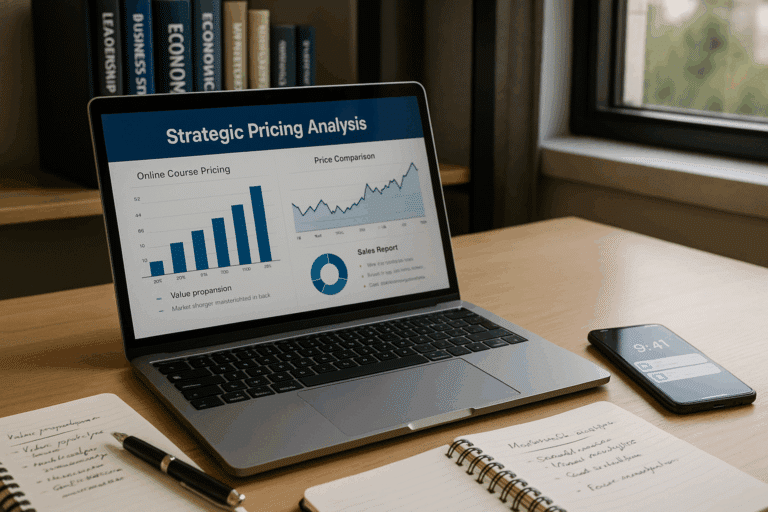This unique approach, blending pedagogy with business savvy, can exponentially increase both your impact and revenue.
Indeed, digital course licensing represents a largely untapped opportunity, ripe with potential. By sharing your valuable expertise with organizations, you can extend your educational reach while simultaneously establishing a new revenue stream. 🎯
Let’s consider the facts. We live in an era where ongoing learning is not only valued but also required for professional growth. Organizations worldwide are seeking ways to empower their employees with new skills and knowledge. By licensing your courses to such organizations, you can step into this critical role as a provider of top-tier educational content. 💼
However, while the potential benefits are undeniably attractive, the process of course licensing is not without its challenges. It requires a careful blend of strategic planning, targeted marketing, and efficient course design. A haphazard approach could result in lost time, resources, and opportunities.
Thus, the question arises: How do you license your course to organizations effectively? What key steps should you take, and what pitfalls should you avoid? These are the questions we’ll be exploring throughout this article.
Specifically, we’ll start by discussing the benefits of course licensing, delving into the ways it can enhance both your educational impact and your bottom line. Next, we’ll explore how to create a course that’s attractive to organizations – touching upon aspects like relevancy, comprehensibility, and applicability. 📚
From there, we’ll dive into the business side of things, outlining how to set a pricing strategy that’s lucrative yet fair. We’ll also provide insights on how to identify potential organizations for your course, and how to pitch your offering in a way that addresses their specific needs.
Finally, we’ll touch upon the logistics of course licensing, addressing issues such as intellectual property rights, contract negotiation, and customer support.
By the end of this article, you should have a clear roadmap on how to license your course to organizations, positioning you to tap into a whole new level of impact and revenue. So, whether you’re a seasoned course creator looking to expand your business, or a newcomer eager to make a splash in the digital education scene, this comprehensive guide is designed to help you navigate the promising terrain of course licensing. 🚀
Without further ado, let’s begin our deep dive into the intriguing world of course licensing.
🚀 Expand Your Reach: Licensing Your Course to Organizations
Whether you’re an established course creator or a newbie to the educational space, licensing your course to organizations can be a game-changer. With the digital age revolutionizing learning and development, more organizations are seeking external resources to meet their training needs. Your course could be the solution they need. But how do you get there? Let’s dive in.
Before we delve into the nuts and bolts of course licensing, it’s important to understand the lay of the land. Businesses today are investing heavily in employee training and development. According to the 2020 LinkedIn Learning Report, 57% of learning and development professionals expect to spend more on online learning. Your course could tap into this growing market, potentially multiplying your impact and revenue.
The trick, however, lies in effectively licensing your course to these organizations. This requires an understanding of your target organizations, course scalability, and successful negotiation strategies.
🎯 Understanding Your Target Organizations
Like any successful venture, understanding your target market is crucial. Organizations, like individuals, have unique learning and development needs. Some may require leadership training, while others may need technical skills development. Understanding these needs can help you tailor your course accordingly, making it more attractive for licensing.
Additionally, understanding the corporate culture and learning methods of potential licensees can be highly beneficial. For example, a tech startup may prefer a more casual, interactive course, while a traditional corporate organization may prefer a more formal, structured approach. This insight can guide the development or adaptation of your course, ensuring it aligns with the licensee’s needs and preferences.
Research is key here. Take the time to understand industry trends, challenges, and the unique needs of potential licensees. This will not only inform your course development but also help you communicate your course’s value effectively.
💼 Licensing Your Course: The Process
Licensing a course involves several steps, starting from course development to contract negotiation. Before you approach potential licensees, ensure your course is professionally developed, engaging, and valuable. The better your course, the more likely organizations are to license it.
Once your course is ready, identify potential licensees. These could be organizations within your niche, companies facing challenges your course could address, or businesses actively investing in training and development. Create a compelling pitch that highlights the value of your course and how it can benefit the licensee.
Upon expressing interest, you will need to negotiate the terms of the license. This includes the license fee, the duration of the license, and any restrictions on course use. Be prepared to negotiate and always consider the licensee’s perspective to reach a win-win agreement.
🔎 Course Scalability and Adaptability
When licensing your course to organizations, scalability and adaptability are crucial. Your course must be able to accommodate the organization’s size and diversity. This may require creating additional modules or adapting existing ones to cater to a wider audience.
Moreover, your course must be adaptable to different learning environments. This includes mobile learning, self-paced learning, and instructor-led training. Consider using a learning management system (LMS) that offers these features to enhance the value of your course.
Your course should also be easily updated to stay relevant and valuable. With industries evolving rapidly, courses that stay current are more likely to be licensed.
📊 Increasing Your Impact and Revenue
Licensing your course can significantly increase your impact and revenue. By reaching a larger audience, your course can make a greater difference. Additionally, licensing can provide a steady revenue stream, especially with recurring licensing agreements.
To maximize your impact and revenue, consider using a tiered licensing model. This allows you to offer different licensing options based on the size and needs of the organization. Smaller organizations could choose a less expensive option with fewer features, while larger organizations could choose a more comprehensive, higher-priced option. This model not only caters to a wider range of organizations but also maximizes your revenue.
To effectively license your course, consider partnering with an experienced licensing agent. They can guide you through the process, negotiate favorable terms, and help you reach a larger market.
🎥 Recommended Video Resource
To delve deeper into the topic of course licensing, I recommend watching the video “How to License Your Online Course to Corporate Clients for Passive Income” by High Ticket Course License Experts on YouTube. This video provides a comprehensive guide on course licensing, including tips on course development, identifying potential licensees, and negotiation strategies.
👀 In Summary
Licensing your course to organizations can be a powerful strategy to expand your reach, impact, and revenue. With businesses increasingly investing in online learning, the demand for quality courses is high. By understanding your target organizations, developing a scalable and adaptable course, and negotiating effectively, you can tap into this lucrative market. Remember, the better your course, the more likely it is to be licensed. So invest in creating an engaging, valuable course that organizations can’t resist.

Conclusion
In conclusion, the key insights gained from this extensive discussion on the importance of technical writing in IT and engineering fields cannot be overstated. The capacity to elucidate intricate concepts in a manner that is accessible and comprehensible is a skill that is not only in high demand but is also a necessity in the fast-paced world of technology and engineering. 👩💻👨💻
By delving deep into the nuances of technical writing, we have underlined its value as a powerful tool to bridge the gap between complex technical jargon and the target audience, be it experts, non-experts, or both. Additionally, we have highlighted the critical role it plays in ensuring the smooth operation of IT and engineering-related projects, demonstrating its integral part in the field. 🖊️📚
The importance of maintaining accuracy, clarity, and conciseness in technical writing has been emphasized throughout. It’s a balancing act that requires a deep understanding of both the subject matter and the audience. The ability to juggle these elements effectively can make the difference between a well-executed project and a potential disaster. ⚖️💡
We’ve also touched on the significance of structure and organization in technical writing. It’s not enough to have all the relevant information; how it’s presented can make or break its effectiveness. Careful attention to detail, logical sequencing, and appropriate use of visual aids are all part and parcel of successful technical writing. 📝🔍
Furthermore, we’ve underscored the significance of continuing professional development. The fields of IT and engineering are continually evolving, hence, so should your skills as a technical writer. Staying up-to-date with industry trends and advancements is a must to stay ahead of the game. 🚀🎯
I hope you have found this discourse on technical writing enlightening and useful. As professionals in the IT and engineering fields, we have a responsibility to disseminate knowledge in a way that is clear, concise, and accessible to all. Remember, good technical writing is not about dumbing down complex information, but rather, it’s about making complexity understandable. 🌐🤝
I would encourage you to take what you have learned here and apply it in your respective fields. Your ability to communicate complex ideas in a comprehensible manner could make a significant difference in your career trajectory. Don’t underestimate the power of good technical writing—it could be your ticket to new professional heights! 💼📈
Your comments, thoughts, and experiences on this subject matter are most welcome. Let’s continue the conversation in the comment section below. If you found this article insightful, don’t hesitate to share it with your colleagues and friends. They too might find it beneficial. 💬🔄
References:
[1] TechWhirl – What is Technical Writing?
[2] Impact Plus – Technical Writing Examples & Tips
[3] Nielsen Norman Group – How Users Read on the Web
Finally, remember that learning is a continuous journey. Be curious, be proactive, and never stop learning. The world of IT and engineering is vast and exciting—let’s explore it together. 👣🌏
Until next time, keep writing, keep learning, and keep growing. 🚀🙌
P.S. Don’t forget to subscribe to our newsletter for more in-depth discussions on topics related to IT and engineering. 📧
Let’s make complexity understandable together! 🤝🌐



